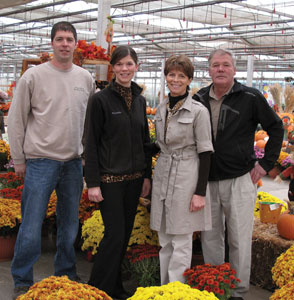3/15/2010
Tried and True
Barbara Mulhern

Why would a predominantly retail greenhouse business in East Central Minnesota—where temperatures frequently plummet to -30F or -40F during the winter months—remain open year-round?
For Green Barn Garden Center in Isanti, Minnesota, the answer is simple: So gardeners and other plant lovers always have a place to go.
“Our customer base is very middle class, even lower- to middle-income, and we are in a rural area,” says Cathy Sparks, who, with her husband Tony, owns the longtime family greenhouse operation. “There are no other greenhouses in our area. Our retail store is open year-round and carries a lot of hard goods. We’re full when most stores have little left for gardening. That helps people a lot, especially when they are looking for gifts.”
Cathy, whose son Donny is the grower and daughter Kelsey is in charge of the greenhouse and the plant and nursery stock orders, notes that other greenhouses in the area “have gone under in the last few years,” she says. “We do have Lowe’s and Menards close to us—also a super Walmart. They are all just 15 minutes away.”
Yet that doesn’t deter Green Barn, which started out as a small vegetable stand in 1957. After being painted bright green, people started calling it the Green Barn and the name has stuck ever since.
Tony and Cathy took over the business from Tony’s parents in 1982. Today, Green Barn, which has about an acre under plastic and additional farmland outdoors, grows and sells a variety of product for its retail and wholesale customers.
On the wholesale side, Green Barn provides customers with certified seed potatoes and onion sets. “We had a seed company separate from this business for 10 years but then sold it,” Cathy notes. Retail customers, who make up about two-thirds of overall sales, can purchase a wide range of products including vegetable seeds, vegetable plants, marigolds, petunias, fertilizer and Proven Winners plants.
“We have one whole marigold greenhouse. They’re really tried-and-true,” Cathy says. “We also stick with very good products in soil amendments. And we carry bedding straw used for ground cover.”
“It’s Who We Are”
Cathy credits Green Barn’s long history in the area—and its continuation of some traditions from years ago—for retaining customers even during tough economic times.
“Our strongest customer base is within 20 miles in all directions,” she says. “We’re about 30 miles north of the Twin Cities and everyone used to take Highway 65 (where Green Barn is located) to go up north. But now there are other highways, including the Interstate, so we don’t get the heavy traffic we used to have.”
Green Barn, however, has remained tried-and-true to its rural customer base. “For example, we’ve always had giant piles of pumpkins in our store and we never got rid of having boxes of candy for the kids. It’s who we are,” Cathy says.
The down economy has resulted in cutbacks over the last several years, but has also resulted in opportunities. For example, Green Barn had a few satellite greenhouses it decided to turn over to the people who owned them in the past. “It became easier for us to just deliver to them. They fax us what they need each morning,” she says.
On the positive side, the growing trend toward edible gardens has resulted in customers coming from Minneapolis to purchase such products as celery and eggplants. “We carry things they just couldn’t find anywhere else. This past year, we also sold a lot of dried beans because people were making a lot of soup. When people come in, what they say to us is: ‘You have everything here.’ Even if it’s something that’s a little out of our price range, we still carry it,” Cathy says.
Another way Green Barn has adjusted to the economy is by “being a little more careful with certain items we might have carried a lot of before such as fountains, bird baths and pottery. Our diversification has helped,” she says.
Helpful Tips
Cathy has these suggestions for other small greenhouse growers:
Determine what marketing works best. In Green Barn’s case, its best advertisement is its outdoor signage, so Cathy and her family members constantly work on it. “Our sign is a giant tree, but we keep changing the wording on it. We don’t have flashing and blinking because traffic goes by here at 65 miles per hour and people wouldn’t be able to read it,” she says.
Visit other greenhouses and industry trade shows. “As much as we’re busy, no matter where we go we always visit garden centers. I tell my daughter that if she sees even one thing she likes to try to incorporate that into something here,” Cathy says. Greenhouse growers just starting out should also try to attend major trade shows in such cities as Chicago and Atlanta, Cathy believes.
Don’t underestimate the time it will take to run a successful business. “Time is really critical for us here,” Cathy says. “There is no down time. I get one week off and that’s all.”
Have strong customer-oriented goals. “We keep changing things and try to have something new each year to get our customers excited,” she says. One of Green Barn’s biggest customer goals is to “get the kids when they’re young and keep them coming back for Halloween and other events so they continue to come back when they’re in their 30s with their own kids,” she adds.
GT
Barbara Mulhern is a freelance writer from Verona, Wisconsin.